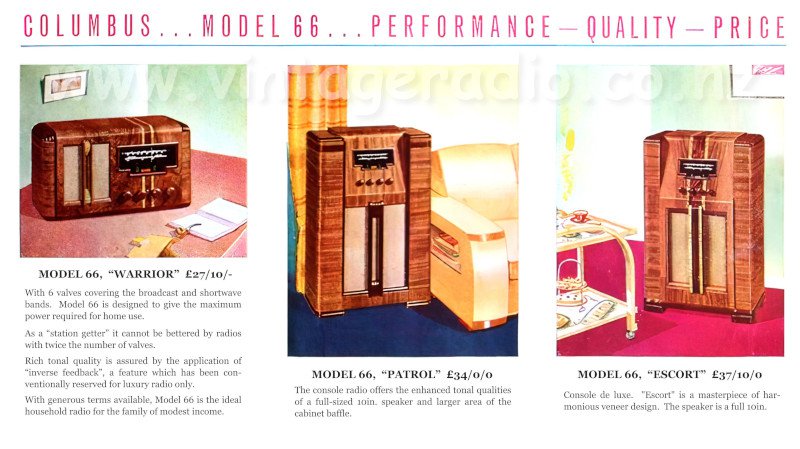Other radios based on the same chassis:
6-valve dual-wave radio (bandspread). Last of the wartime models before restrictions kicked in.
In 5 known cabinet variants - the table model: Warrior, tablegram: Pennant and 3 console models in order of opulence: Discovery, Patrol and Escort
One of RCNZ's longest-running models (alongside the model 75) - although this was partly due to the war suspending domestic production.
There was a battery model equivalent, the model 70.
This model was also subject to many modifications over its life. This page covers the pre-war variants: 66, 66E and 66J. See the model 66A page for the post-war variants: 66A and 66W. The model 66R is known to exist, but its unknown at the stage what the differences are - sighted examples appear to have 1946 & 1947 date codes. The final version seems to be the 66T from 1947. No service information is held for the R or T.
| Model | Date Codes Sighted |
| 66 | 1941 |
| 66E | 1941 (late) |
| 66J | 1942 |
| 66A | 1945 |
| 66W | 1946 |
| 66R | 1946 |
| 66T | 1947 |
a 5-valve version (the model 56) was produced although it does not seem to have been nearly as popular or long-lived.




Model 66 brochure, digitally remastered by SJD
The model 66 was one of the longest-running models from Radio Corp, released during the opening years of World War 2 and running through until around 1949 when it was succeeded by the model 166.
It came in multiple variants over the years it was produced - likely brought about by wartime shortages forcing componentry changes.
There was a 66BC which has been included in this series for completeness although it is broadcast-band only - but it does appear to use the standard model 66 chassis with the dual-wave coils unpopulated.
There is also a model 56, which is a 1941-released 5-valve dual wave - which seems to have been coded to sell as a city-use version of the 66.
Valves (6):
Model 66 and 66J: 6K7G, 6K8G, 6B8G, 6J7, 6F6G, U50 or 5Y3G
Model 66E: 6K7G, 6K8G, 6B7, 6C6, 6F6G, U50 or 5Y3G
Intermediate Frequency: 455kc/s
Frequency Bands: 2
Chassis Notes(most schematics can be clicked to download a full size version)
Available in several different chassis variations, including the original model 66, 66E, 66J, 66A and 66W. See schematics for notes on differences
General Construction Notes for Radio Corporation of New Zealand Ltd:
The first digit of the serial number typically indicates the year of manufacture of RCNZ chassis' (although not the decade - that requires a little knowledge of the valves, construction, etc). Sets from around 1934 onwards were often (but not always) constructed in a distinctive pressed 'baking pan' style chassis, seemingly unique to RCNZ.
Model codes beginning with a 0, for example the model 051, are Osram valve versions of the model without the leading 0. Technically the 0 should be an O (for Osram), however the digit 0 was used throughout the site before this fact was discovered.
The E suffix indicates a magic eye option is fitted (in models which were available with or without, such as the model 25).
A and B suffixes appear to be simply updates to the current model, R also appears to be simply an updated model ('R'edesign, perhaps?)
P indicates either a permanent magnet speaker version of a model which also came with an electromagnet speaker (the model 26 for example), or a portable model (like the model 694P). This suffix was used in the mid 50's when Radio Corp was changing over.
N and M indicated miniature valve versions of a model which started with all (or a mix, ie: model 5) of larger valves. One of these two codes may indicate a transitional mixture of octal and miniature - clarification is required.
S often indicates a stereo model. It can also indicate 'self-biased' in the transition period between back-biased and self biased sets where there were models with both methods employed (53S for example)
Finally, other suffixes and prefixes make occasional appearances in the RCNZ lineup - like the 66W (a variant of the long-running model 66) and the 75XA (a 10-valve version of the model 75 with a separate amplifier chassis).
Model nicknames are often sourced from either newspaper advertising, company literature or the NZ Radio Traders Federation official trade-in price books (Particularly Courtenay models from this publication)
In 1954, model numbering changed, to begin with the number of valves (ie: 501 - 5 valves, 1006 - 10 valves, etc) although the final 2 digits don't appear to have much significance. Middle digits of 5 (portable) or 6 (mantle, including clock radio) are used on the AWA-designed plastic-cased sets.
| YEAR | MODEL NAME |
|---|---|
| 1941 | Courtenay model 66 'Rata' |
| 1946 | Courtenay model 66BC |